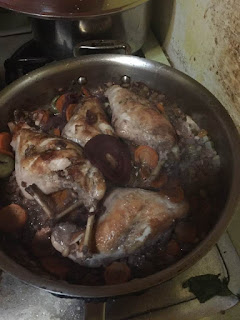Ragazzi, Annalena does not think of herself as a stickler for terminology, although maybe she is. she does like to know what to expect when she's eating, or reading a recipe. You know this drill, Annalena has written of it before: if the recipe says "florentine," there is going to be spinach. WHY? No one knows. If it says "au gratin," there's cheese. And it goes on: if it says "Chinese style," (oh, what a horrible description), there's soy sauce in it. You know the type of recipes.
But there ARE specific foods which have specific names. Ratatouille, for example, means eggplant, squash, and tomatoes to Annalena. PERIOD. Caponata means eggplant, capers, tomatoes, and sweet and sour. PERIOD. Yes, there are other things that could be added, but this is it. "Cacio e pepe," that wonderful simple yet complex Italian dish, is fresh ground pepper, and (because no one can find true "cacio" anymore), parmesan. Nothing else. NO, no butter. NO, not a mixture of pecorino and parmesan. NO NO NO.
So, this recipe - which is ridiculously simple and wonderfully rewarding, was advertised as "caponata ratatouille."
HUH???? Now that is a new one on Annalena. She had no idea what it meant. In reading through the recipe, it appears that the author, because of the presence of eggplant/tomatoes and zucchini, (in the original recipe), couldn't make up his mind as to what to call it; however, there is no basil in it (always there in ratatouille), and there are no capers in it (always there in caponata), so he just made up a name.
Bad, bad bad. So we are not going to call it either one , ragazzi, we are just going to call it good, and easy. And now, we're going to make it. And wait until you see the liberties you have with this one.
First, ANNALENA's ingredients:
She writes "Annalena's ingredients," because these are not exactly what the recipe called for. Indeed, the recipe called for larger tomatoes, so you could cut them in half, and for summer squash, which Annalena did not have. She did have a small "honey nut" winter squash (about 1/4 the size of butternut squash), and she had "heirloom cherry" tomatoes, which included 2 large tomatoes and a bunch of small ones.
Look at those ingredients. You see fennel, yes? And red peppers. and chickpeas. None of these are seen in either ratouille or caponata. Peppers are seen in Turkish dishes with eggplant, but Annalena is unaware of the use of fennel or of chickpeas in any of these dishes.
NO MATTER CARISSIMI. Let's make this simple dish. The quantities are flexible: a pound of eggplant (Annalena used more), two red peppers, an onion, two medium sized bulbs of fennel, a pound of tomatoes, a pound of zucchini (Annalena used her winter squash), and five cloves of garlic. You should peel the garlic, but you don't have to, as Annalena will explain beow.
You also see a couple of cups of cooked chickpeas on the side. If you must, use canned, but do put these in.
In the original recipe, there was call for peeling small Japanese eggplants.
As Annalena's former assistant would say "Get Bent." If you peel Japanese eggplants, especially small ones, as with Oakland "when you get there there's no there there." Annalena sees no need for doing this. Do cut large tomatoes up, but don't feel required to do so with small ones. And if you don't have fresh, drain the juice of a can of plum tomatoes (28 ounces, 32 ounces, WOTEVER), and use these.
So, preheat your oven, to 425, while you're cutting all these guys up:
Toss them on a baking sheet with olive oil, and salt, and put them in the oven. Go away for 45 minutes to an hour . Hold off on the chickpeas. If you are so inclined, stir them once or twice.
With this many vegetables, you are not going to get browning, and that's ok. This is not a dish caling for browning.
After the baking, dump the vegetables in a bowl, and stir in the chickpeas:
Now we have some fun: WE PICK THE ACCESSORIES. First, taste this to see if it needs salt, and add it if it does. You can finish here and now, but.... Annalena suggests you add some red wine vinegar. And after that, some honey. If you do not have honey, use sugar, but BUY SOME HONEY!!!! And taste again. If you have them, add some golden raisins. Annalena did. If you want to, add some green olives. Annalena did not. And if you want, squeeze the garlic out of the skin if you were too lazy to peel them. Annalena was, so she did.
It will be wonderful. And you're done:


















































